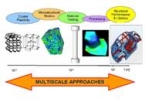Project objectives
1. Experimental characterization of selected sheet metals at micro and macro level
The goal here is to create a broad behavioral map of selected aluminum alloy sheets that have important applications, or perspectives, for the automotive and canning industries. We will thus select a range of aluminum alloy sheets representative for such applications – AA6111 for earing prediction in deep drawing, AA5182 showing PLC effect, and superplastic AA5183 where porosity and damage play an important role. For these alloys, directional properties and hardening curves will be determined by tensile tests and hydraulic bulging. Texture evolution will be measured along as many and as diverse as possible strain paths: successive rolling, non-proportional strain paths, off-axis loadings to determine the plastic spin, etc. Texture will be determined by X-ray and EBSD techniques, while microstructure (porosity, second phase particles, etc.) will be determined by electronic microscopy and metallography. We will develop software for the automatic data/image processing of porosity maps, a new method for determining biaxial yield points by hydrostatic bulging of elliptic sheets and imaging software for automatic determination of necking instants and forming limits. Experimental forming limits diagrams for both linear and complex strain paths will be determined.
2. Micro and macro level models for the constitutive behavior of plastic sheets
The hierarchy of scales we want to model goes from single crystal plasticity through polycrystal plasticity, based on texture and porosity measurements, to phenomenological plasticity and finally to models for PLC, deep-drawing and forming limit diagrams. Each model is active at a different scale and will supply parameters and motivation for the phenomenology of the models above it. We will evaluate existing models and use or extend them to improve their predictive capabilities.
3. Numerical and software implementation of proposed constitutive models
We will develop stand-alone software for comparing the proposed constitutive models to experiments, user subroutines for finite element codes implementing these models and finite element simulations for various structures (RVE, deep drawing, hydrostatic bulging, etc.). Stand-alone software will be developed for Forming Limit Diagram predictions, including the polycrystal models (Taylor, VPSC), the anisotropic and polycrystal Gurson models for porous sheets, the phenomenological anisotropic model for based on texture. Finite element simulations will be used to model a representative volume element for the direct polycrystal model. Another thread will develop numerical schemes and implementation for the PLC phenomenological model, using energy control of numerical stability in thermo-elasto-viscoplasticity.
4. Validation of software and models by comparison with experimental results
The objectives here are to validate the proposed models and their software implementation by comparing their prediction with experimental results obtained in WP 1. First we will validate the geometric and process measurement methods for hydrostatic bulging and deep drawing of a cylindrical cup. Then we will validate the structural calculations for uniaxial tensile tests, the stand-alone software for predicting FLD for materials with voids, showing PLC effect, and the phenomenological anisotropic models. Finally we will validate the structural calculations for hydrostatic bulging and deep drawing.
